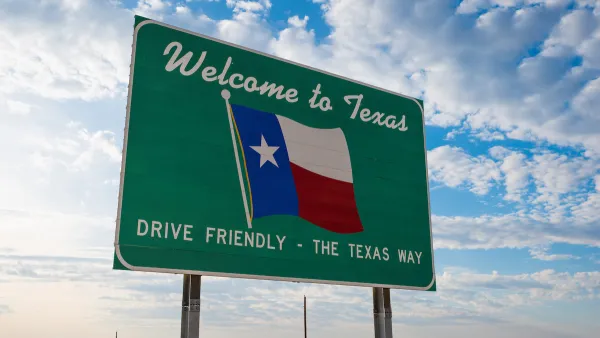Despite its ambitious emissions reduction goals, California continues to spend a majority of transportation funds on car-centric infrastructure.

The Los Angeles Times editorial board takes California state leaders to task on its climate goals, charging that “when it comes to cutting the state’s biggest source of planet-warming emissions — cars, trucks, airplanes and other modes of transportation — the spending doesn’t match the rhetoric.”
The editorial references two recent reports that reveal a lack of progress on the state’s promise to cut vehicle miles driven and reduce greenhouse gas emissions. One report from NextGen Policy shows that “traffic and car dependence has increased in recent years.” The board writes that this is largely because the state “continues to spend the bulk of its transportation dollars to maintain and expand car-centric roads and freeways.”
However, “Instead of doubling down on the existing system that makes it inconvenient and unsafe to travel by bike, foot and transit, California should be spending the bulk of its transportation funding to remake the urban landscape so people have real choices in how they get around.” In fact, only 19 percent of transportation funding has gone to non-driving projects such as public transit, bike lanes, and pedestrian infrastructure.
According to the editorial, “About 70% of the state’s transportation dollars go to road maintenance, as required by the state’s gas tax spending plan.” But, if used strategically, this funding could also support bike and pedestrian infrastructure.
Ultimately, the board writes, “The state needs to radically redesign its transportation system to reduce the need for people to drive everywhere all the time.”
FULL STORY: Editorial: California’s transportation spending doesn’t match its climate promises

National Parks Layoffs Will Cause Communities to Lose Billions
Thousands of essential park workers were laid off this week, just before the busy spring break season.

Retro-silient?: America’s First “Eco-burb,” The Woodlands Turns 50
A master-planned community north of Houston offers lessons on green infrastructure and resilient design, but falls short of its founder’s lofty affordability and walkability goals.

Delivering for America Plan Will Downgrade Mail Service in at Least 49.5 Percent of Zip Codes
Republican and Democrat lawmakers criticize the plan for its disproportionate negative impact on rural communities.

Test News Post 1
This is a summary

Test News Headline 46
Test for the image on the front page.

Balancing Bombs and Butterflies: How the National Guard Protects a Rare Species
The National Guard at Fort Indiantown Gap uses GIS technology and land management strategies to balance military training with conservation efforts, ensuring the survival of the rare eastern regal fritillary butterfly.
Urban Design for Planners 1: Software Tools
This six-course series explores essential urban design concepts using open source software and equips planners with the tools they need to participate fully in the urban design process.
Planning for Universal Design
Learn the tools for implementing Universal Design in planning regulations.
EMC Planning Group, Inc.
Planetizen
Planetizen
Mpact (formerly Rail~Volution)
Great Falls Development Authority, Inc.
HUDs Office of Policy Development and Research
NYU Wagner Graduate School of Public Service





























